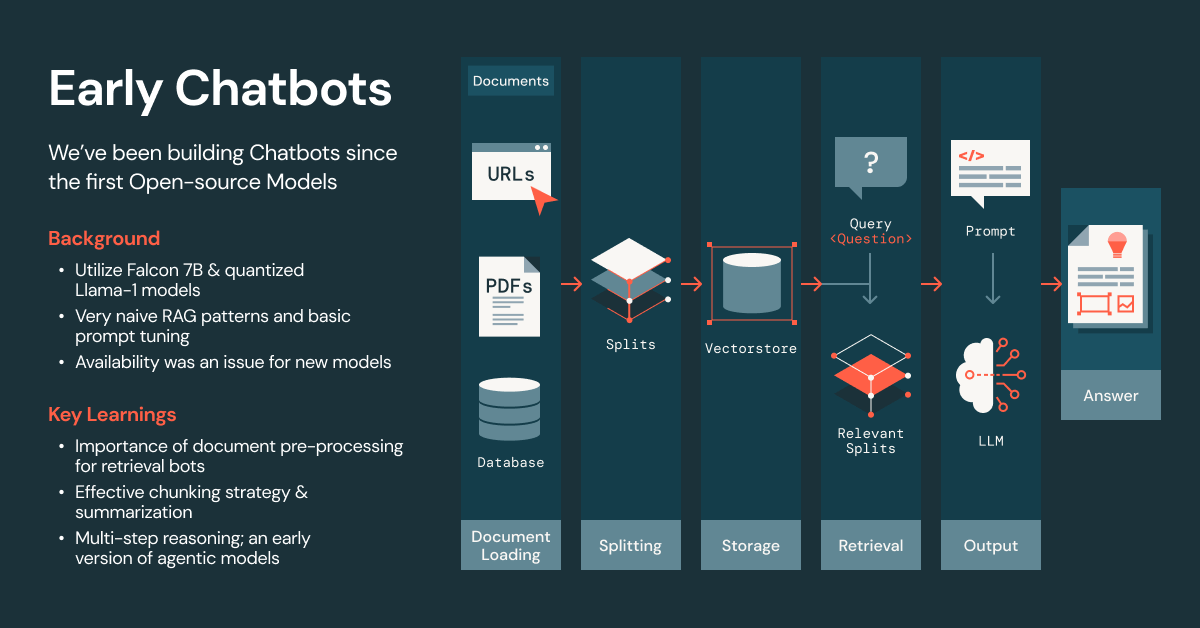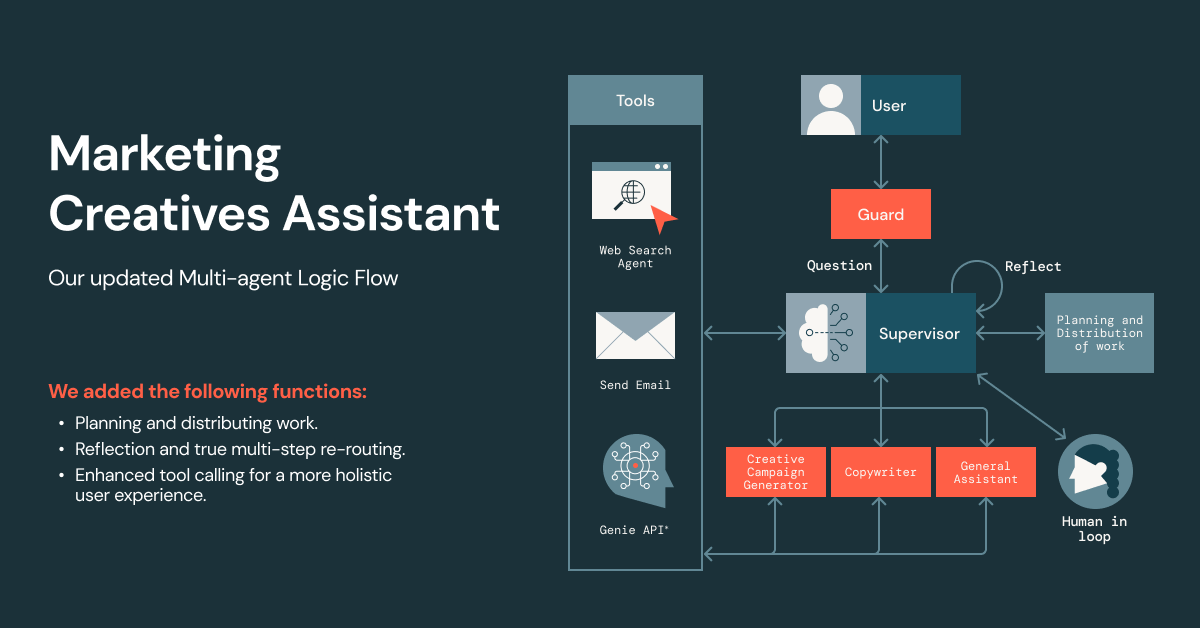How 7‑Eleven, Inc. Built a Game-Changing GenAI Creative Assistant for Marketing with Mosaic AI
Discover how 7‑Eleven’s AI Center of Excellence developed a secure, highly tailored GenAI assistant—accelerating campaign ideation, saving analyst hours, and delivering measurable business impact for marketing teams nationwide.

Summary
- Learn how 7‑Eleven’s bespoke GenAI assistant automates campaign ideation and copywriting, freeing teams to focus on strategy instead of repetitive creative work.
- Explore the technical evolution, from early chatbots to a multi‑agent architecture with reflection, human‑in‑the‑loop controls, and Databricks Mosaic AI integration.
- See how brand‑specific workflows, governance, and seamless orchestration drove adoption—with users calling it “a game changer” and “better than ChatGPT.”
Inside 7‑Eleven’s Push to Reinvent Marketing with GenAI
7‑Eleven, Inc. is a global retail leader with 85,000 stores in 19 countries, and more than half of the U.S. population lives within two miles of a location. Alongside its iconic convenience store footprint, the company has a track record of in‑house technology breakthroughs—from AI‑powered cashierless stores to proprietary fuel and delivery systems.
As marketing shifted into digital channels, campaign demand surged. Every brief required fresh creative concepts, multi‑channel copywriting, and flawless brand alignment. Existing vendor chatbots fell short: they lacked a consistent brand voice, were challenging to govern, and could not deeply integrate into established workflows. The business saw a clear need for a secure, fast, and enterprise‑specific GenAI assistant that could make creative development smarter and safer.
From Chatbot Graveyard to Production-Ready Value

Early Experiments and Key Learnings
Initial efforts focused on simple document‑based chatbots and basic retrieval‑augmented generation (RAG). These tools managed straightforward queries but faltered when handling long, complex, image‑heavy content. Three strategic lessons emerged:
- Generic models couldn’t meet brand standards; success required tailored prompts, defined agent roles, and embedded business context.
- Governance was essential for protecting unreleased campaign data and enforcing compliance.
- Adoption hinged on accessibility, such as embedding in Microsoft Teams, and delivering outputs that stakeholders could act on immediately.
These insights informed the blueprint for a production‑ready marketing assistant.
A GenAI Marketing Assistant Built for Speed, Safety, and Creative Impact
Business-First Design
Working side by side with internal marketers, the AI team delivered an assistant custom fit for real-world creative workflows:
- Campaign Creative Generator: This generator produces campaign concepts, taglines, stories, and channel strategies based on parameters like audience, geography, and tone.
- Copywriter Bot: Specializes in crafting precise, channel-specific copy for emails, videos, radio scripts, and app notifications, all in the approved brand voice.
- General Assistant: Handles broader marketing questions and facilitates ideation, ensuring no creative roadblock halts progress.
- Supervisor Agent: This orchestrates the workflow, routes requests, reviews outputs for quality, and coordinates multi-agent collaboration.

Custom configurations allowed users to select tone of voice, demographics, call to action, and more, making every output hyper-relevant (and fully branded).
A Multi-Agent, Human-in-the-Loop System—Built for Quality and Trust
The solution evolved from simple request routing to a multi-agent orchestration model, delivering both creative adaptability and control. Built on LangGraph and Databricks Mosaic AI, the system choreographs multiple agents—each with its own role and guardrails—into a seamless creative workflow.
LangGraph handles the complex orchestration: managing task flows, sharing memory across conversations, integrating tools like web search and email automation, and inserting human reviewers exactly where they add the most value. This allows the assistant to move beyond answering questions to actually planning, reflecting, and iterating like a seasoned creative partner.
Mosaic AI provides the scale, governance, and observability to make this sustainable in a fast-moving business. With built-in MLflow tracking, the team can monitor decision-making end-to-end, confidently tune prompts, and use automated agent evaluation to measure groundedness, safety, and relevance before deployments hit production. Inference tables and layered guardrails ensure performance and compliance aren’t afterthoughts—they’re designed into the system from the start.
Key capabilities include:
- Reflection and Quality Control: The supervisor “thinks aloud,” plans steps, and double-checks campaign requirements to prevent stray outputs.
- Web Search Agent: Gathers trend intelligence and ensures new campaigns aren’t recycling stale or competitor ideas.
- Human-in-the-Loop: From live UI interruptions to email reviews, humans can check, guide, and approve content at any workflow stage—bolstering compliance confidence.
- Guardrails Everywhere: Toxicity, PII, and off-policy responses are filtered before any output leaves the system.
How the Assistant Transformed Creative Workflow
Before the assistant, concepting and scripting for a multi‑channel campaign could take hours or days, with multiple hand‑offs between creatives and reviewers. Now, those exact deliverables can be generated, refined, and approved in minutes. The impact:
- Manual hours saved: The assistant automates ideation, multi-channel scriptwriting, and campaign summarization, drastically reducing the hands-on time marketers require for each campaign.
- Faster, higher quality creative: What used to take hours of brainstorming, copy refinement, and back-and-forth review can now be done in minutes, with iterative improvements possible on the fly.
- Tailored output, higher adoption: By tuning to 7-Eleven’s voice and allowing team-specific configurations, marketers actually use the output in live campaigns, unlike “ideation-only” bots people abandoned.
- Business feedback: User testimonials included “a game changer,” “we told vendors to stand down,” and (their favorite) “better than ChatGPT”, thanks to hyper-customization for the business use case, not just the underlying model.
AI Enablement, Not Just Automation
Beyond efficiency, the assistant enables teams to try ideas they previously couldn’t pursue, such as testing seasonal variations, experimenting with new channels, or running more A/B creative tests. Internal guardrails ensure that campaign data remains secure, while KPI performance data can be used to fine‑tune future content. The result is a virtuous cycle: faster launches, richer experimentation, and data‑driven improvement.
- Risk mitigation: Internal guardrails and governance protect proprietary data, ensuring outputs remain on-brand and safe.
- Scalable creativity: Teams can experiment with multiple campaign ideas, rapidly pivoting strategies and channels based on market trends and recent campaign performance data.
- Empowered marketing teams: Less time on rote tasks, more time on strategy, analysis, and direct business impact.
From Technical Foundation to Strategic Advantage
The success of 7‑Eleven’s marketing assistant wasn’t just about clever prompt engineering or fancy UI, It was about building on the proper foundation. By pairing LangGraph’s orchestration capabilities with Databricks Mosaic AI’s robust LLMOps environment, the team created a platform that is not only powerful today but primed for rapid evolution.
LangGraph gave 7‑Eleven’s engineers a way to choreograph multiple agents, each with its own role and guardrails, into a seamless creative workflow. It simplified the hard parts: orchestrating complex task flows, managing memory across conversations, integrating tools like web search or email automation, and inserting human reviewers exactly where they add the most value. For the marketing teams, this meant their AI assistant could move beyond answering questions to actually planning, reflecting, and iterating like a seasoned creative partner.
Mosaic AI provided the scale, governance, and observability to make this sustainable in a fast‑moving business. With built‑in MLflow tracking, the team could watch the assistant’s decision‑making end‑to‑end, confidently tune prompts, and use automated agent evaluation to measure groundedness, safety, and relevance before deployments reach production. Inference tables and layered guardrails ensured performance and compliance weren’t afterthoughts; they were designed into the system from the start.
This strong base now enables the next leap: moving from ideation to automated execution. The roadmap includes tools to review and approve HTML emails, pull live KPIs from Salesforce and Genie APIs to inform new campaigns, and generate image or video content aligned with 7‑Eleven’s brand assets. The goal is a simple “upload‑to‑output” experience—marketers drop in a campaign brief and receive fully formed creative concepts, copy, and channel plans in their inbox moments later.
For business leaders, the story is clear. The difference between an out-of-the-box chatbot and a transformative AI assistant lies in three principles:
- Custom beats generic: Because the system was tailored to 7‑Eleven’s workflows, data, and voice, marketers actually use, and trust, the outputs in real campaigns.
- AI augments, not replaces: The assistant lightens the load on repetitive creative tasks, allowing people to focus on higher‑value strategy and innovation.
- Governance unlocks scale: Strong guardrails, observability, and a flexible multi‑agent architecture mean the system can grow in capability without losing control.
The payoff isn’t just hours saved—though the time savings are significant. It’s new ideas realized quickly, campaigns launched with greater precision, and a marketing team armed with a creative edge their competitors can’t match.
Never miss a Databricks post
What's next?

Product
August 30, 2024/6 min read
